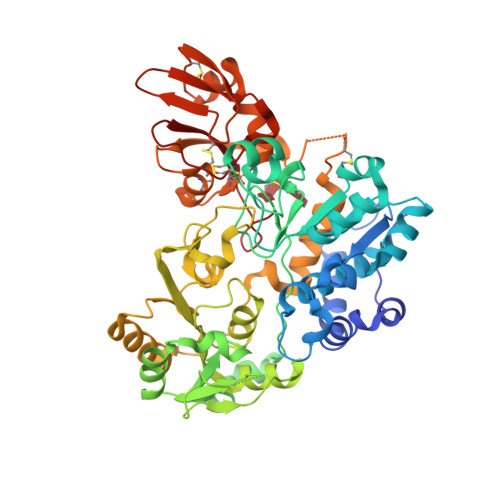A Bioorthogonal Precision Tool for Human N -Acetylglucosaminyltransferase V.
Liu, Y., Bineva-Todd, G., Meek, R.W., Mazo, L., Piniello, B., Moroz, O., Burnap, S.A., Begum, N., Ohara, A., Roustan, C., Tomita, S., Kjaer, S., Polizzi, K., Struwe, W.B., Rovira, C., Davies, G.J., Schumann, B.(2024) J Am Chem Soc 146: 26707-26718
- PubMed: 39287665
- DOI: https://doi.org/10.1021/jacs.4c05955
- Primary Citation of Related Structures:
9F5H - PubMed Abstract:
Correct elaboration of N-linked glycans in the secretory pathway of human cells is essential in physiology. Early N-glycan biosynthesis follows an assembly line principle before undergoing crucial elaboration points that feature the sequential incorporation of the sugar N -acetylglucosamine (GlcNAc). The activity of GlcNAc transferase V (MGAT5) primes the biosynthesis of an N-glycan antenna that is heavily upregulated in cancer. Still, the functional relevance and substrate choice of MGAT5 are ill-defined. Here, we employ protein engineering to develop a bioorthogonal substrate analog for the activity of MGAT5. Chemoenzymatic synthesis is used to produce a collection of nucleotide-sugar analogs with bulky, bioorthogonal acylamide side chains. We find that WT-MGAT5 displays considerable activity toward such substrate analogues. Protein engineering yields an MGAT5 variant that loses activity against the native nucleotide sugar and increases activity toward a 4-azidobutyramide-containing substrate analogue. By such restriction of substrate specificity, we show that the orthogonal enzyme-substrate pair is suitable to bioorthogonally tag glycoproteins. Through X-ray crystallography and molecular dynamics simulations, we establish the structural basis of MGAT5 engineering, informing the design rules for bioorthogonal precision chemical tools.
- Department of Chemistry, Imperial College London, London W12 0BZ, U.K.
Organizational Affiliation:




















